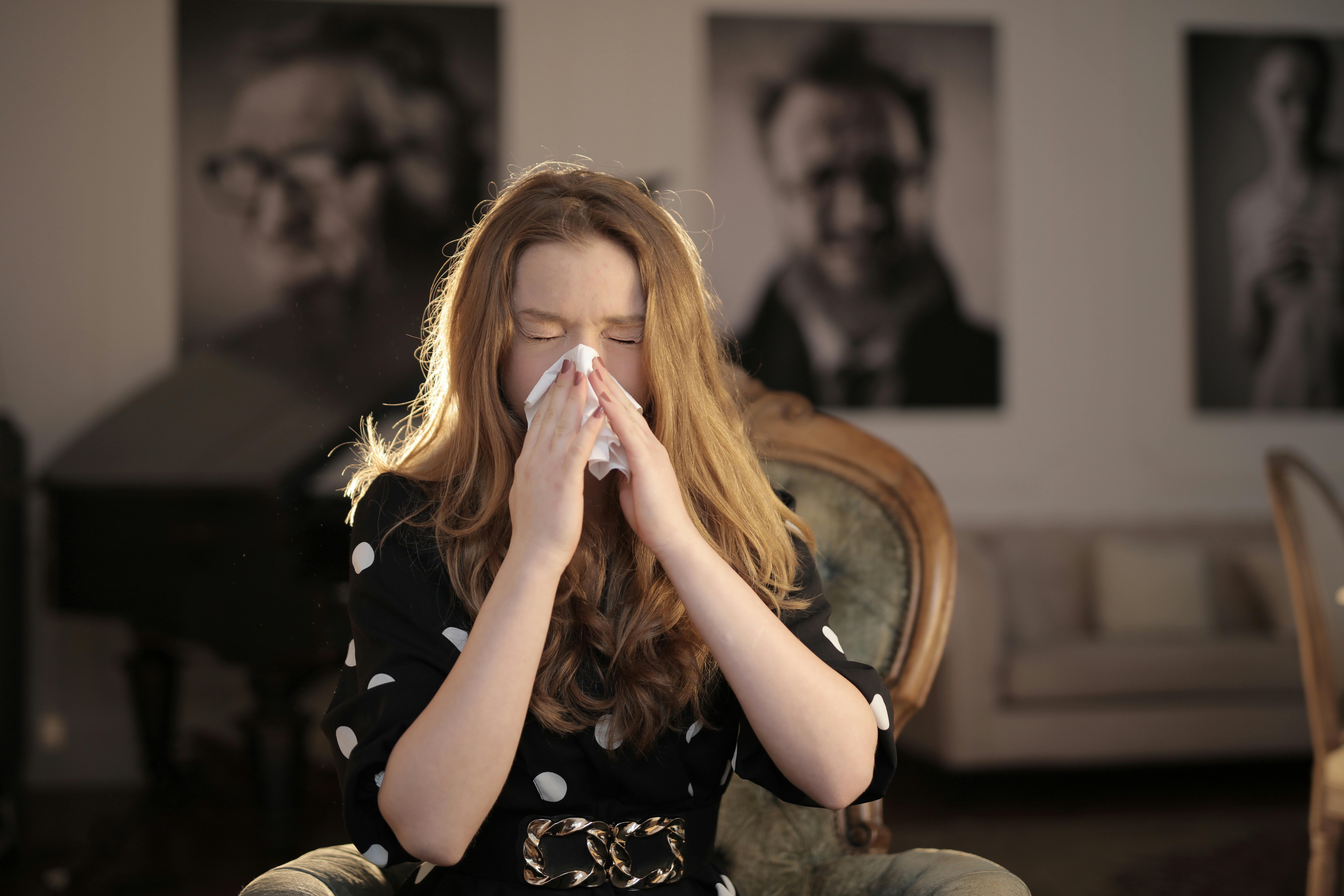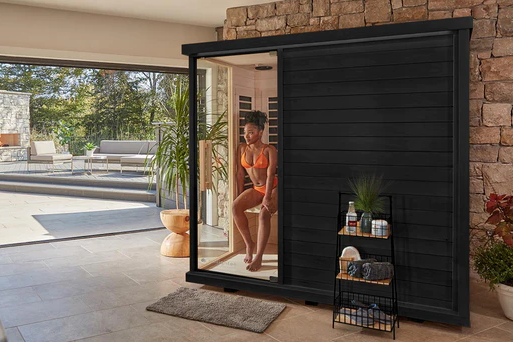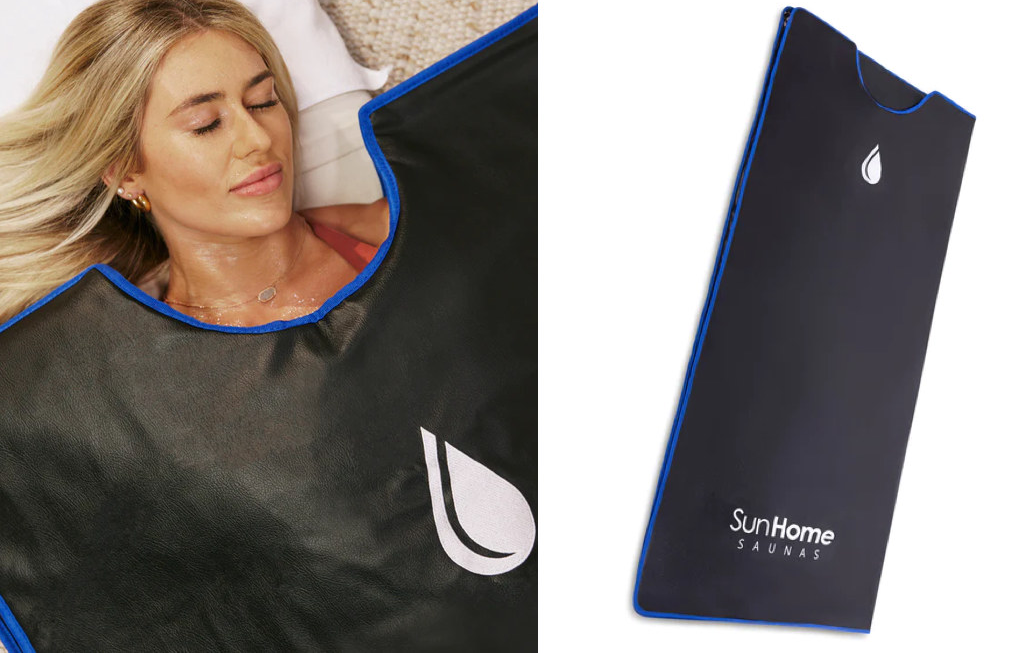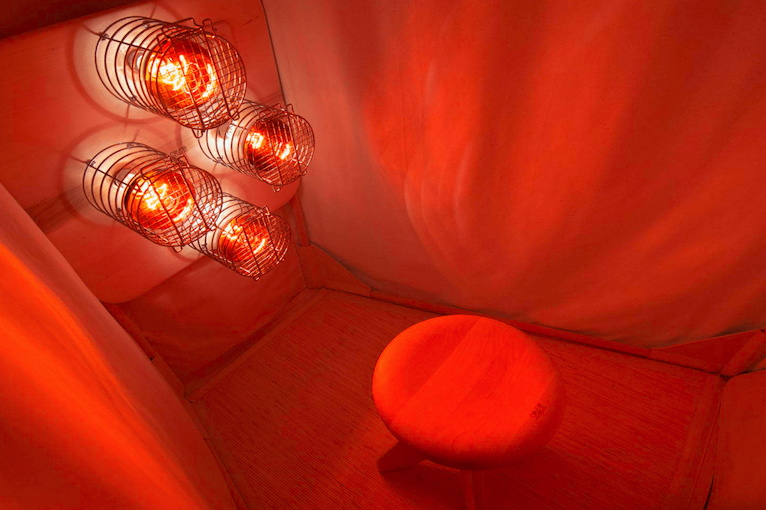- HOME
- Infrared Sauna Benefits
- Allergies
Is An Infrared Sauna Good For Allergies?

Dealing with allergies [1] is tough. Whether it's stomach problems from food, sneezing or skin reactions, allergies can really hold you back. Infrared sauna therapy, while not a magical cure, could provide some relief by supporting your body in managing symptoms. Let's explore how this might work for you.
A quick tour of the blog post
- What are allergies?
- Common treatments for allergies
- Allergies and infrared sauna therapy
- Studies: infrared therapy and allergy relief
- Infrared sauna therapy in practice
Let's begin at the beginning: What are allergies?
The Most Common Allergies
Inhalation Allergies
Also known as allergic rhinitis or "hay fever," affect a significant portion of the population. They are triggered by airborne substances such as pollen from trees, grasses, or weeds, as well as indoor allergens like dust mites, pet dander, and mold spores. The symptoms range from nasal congestion to difficulty breathing.
They can occur seasonal, peaking during pollen seasons, or perennial, occurring year-round due to constant exposure to indoor allergens.
Contact Dermatitis
Allergy Contact dermatitis (ACD) arises when the skin reacts to allergens upon direct contact. Common triggers include nickel, found in jewelry and metal items, latex, used in medical gloves and certain types of clothing, and personal care products like soaps, detergents, and cosmetics. This condition leads to symptoms such as itching, redness, and blistering of the skin.
Food Allergies
These allergies result from the immune system reacting against specific food proteins, mistakenly identifying them as harmful. Food allergies caused by shellfish, milk, peanuts, tree nuts and fish are well known, but there are many more. These reactions can manifest in various ways, from mild digestive discomfort to life-threatening conditions like anaphylaxis.
In the U.S. alone, nearly 1 in 3 adults and more than 1 in 4 children reported having a seasonal allergy, eczema, or food allergy in 2021 (CDC's National Center for Health Statistics). [2]

Bodies' Reaction to Allergy
Allergies start when your immune system mistakes a safe substance for a danger, leading to a strong reaction. This causes histamines [3], which are part of your immune defense and stored in your body, to be released.
These histamines make the walls of your blood vessels "leaky," allowing immune cells and proteins to reach and attack the allergens.
The natural defense mechanism manifests itself in recognizable allergic symptoms such as sneezing, itching and swelling. These reactions occur because histamines dilate blood vessels and irritate nerves.
This results in discomfort and inflammation in different parts of the body, depending on the type of allergy you encounter, whether it concerns the skin, respiratory system or digestive tract.
Common Treatments for Allergies
Allergy treatments vary based on the type and severity of the allergic reaction. Additionally, they often manage symptoms rather than curing the underlying allergy. Let’s break them down:
Avoidance
First-line defense involves minimizing exposure to known allergens, although this isn't always practical, especially with airborne triggers like pollen.
Medications
Antihistamines are the most common medications for allergies. They block the effects of histamine in the body and provide symptom relief from itching, sneezing and runny nose. They are less effective for congestion.
In addition, corticosteroids (nasal sprays, inhalers, topical creams and pills) are often prescribed. These aim to reduce inflammation and are effective for a wide range of allergic reactions.
Immunotherapy
Involves gradual exposure to allergens to build tolerance, particularly effective for severe allergies but requires commitment and isn't suitable for everyone.
While these treatments can bring relief, they may not work for everyone and can have side effects. Like most allergy treatments infrared sauna therapy won't cure allergies, but it might offer symptom relief.

Interplay: Allergies and Infrared Sauna Therapy
Infrared saunas offer a unique experience compared to traditional dry or steam saunas. Instead of heating the air around you, IR saunas use infrared light to directly heat your body, providing a gentle, penetrating warmth.
For those who find the intense heat of conventional saunas overwhelming, the gentle warmth of infrared saunas can provide a more comfortable and enjoyable experience, making it an appealing option for allergy relief.
Like we described earlier when the body's immune system overreacts to allergens, it initiates a series of reactions. This includes the release of histamines, resulting in symptoms like inflammation, itching, and congestion.
Here the infrared sauna therapy comes into play. Presenting its potential benefits for alleviating allergy symptoms:
The gentle heat prompts sweating, facilitating toxin removal (detox) and potentially reducing the immune system's burden and hyperreactivity to allergens.
Furthermore, enhanced circulation from sauna therapy may aid in efficiently removing allergens from the body, lessening inflammation and promoting overall well-being.
Additionally, the relaxation induced by sauna sessions can diminish stress levels, potentially mitigating the severity of allergic reactions.
This interplay emphasizes the unique effect of infrared saunas on our body. But what about scientific evidence on the effects of infrared saunas on allergies?
Exploring the Potential of Infrared Therapy for Allergy Relief
What research is available on infrared therapy and its implications for managing allergies? Well, direct studies on infrared saunas and allergies are still lacking. But we can gain valuable insights from research into the effects of infrared therapy on our body's allergic symptoms.

Impact Sauna Therapy on Allergy Symptoms and Lung Function
A study (2013) of 26 participants with allergic rhinitis examined the effects of traditional dry sauna use over a six-week period, focusing on its impact on the autonomic nervous system, nasal airflow and lung function [4]. The participants were divided into two groups, one of which received a regular sauna treatment three times a week, with each session lasting 30 minutes, alternating with rest periods.
The findings showed a significant improvement in the sauna group:
- Increased sympathetic nervous system activity: This system prepares the body for action during stress (heart rate and alertness). Elevated activity levels can indicate improved body efficiency and adaptability.
- Improved peak nasal inspiratory flow: This is the speed of air intake through the nose. Higher values indicate clearer nasal passages, facilitating easier breathing.
- Better lung function.
These promising results from traditional sauna therapy suggest that infrared saunas, as another form of heat treatment, may offer similar health benefits—worthy of further investigation.
FIR Therapy: A Novel Approach for Allergic Rhinitis Relief
The 2007 study, “Clinical effects of far-infrared therapy in patients with allergic rhinitis (AR),” examined the potential of far-infrared therapy (FIR). [5]
The study involved 31 AR patients. They received FIR therapy every morning for a week, focusing on the nasal area. Patients documented their symptoms daily and rated the severity of eye itching, nasal itching, congestion, rhinorrhea, and sneezing on a four-point scale. The results showed a substantial relief in symptoms.

Embracing Infrared Therapy: Practical Steps
Research and Education
Start off by digging deeper into the world of infrared sauna therapy. Learn about the different types of infrared saunas and what each can offer in terms of health benefits. Making sense of these details will empower you to choose wisely. And don't worry, we are at hand to help guide you through every step of the way.
Consult Healthcare Providers
Before starting any new treatment, especially if you have pre-existing health conditions, consult with a doctor. They can give you personalized advice and make sure that infrared sauna therapy is safe for your specific health scenario.
Find Local Sauna Facilities
Check out nearby gyms, spas or wellness spots with infrared saunas. Here you can experience the sauna atmosphere without investing upfront in a home IR sauna.
Consider Home Sauna Options
If infrared sauna sessions are indeed your game-changer, it's time to explore your home sauna options. Whether you're looking for something you can tuck away, like sauna blankets, infrared PEMF mats or personal tents, or you're ready for a more permanent setup, such as a sauna dome or cabin, there's a whole range to suit your space, budget and preferences.

Discover the best infrared sauna blankets
Ready for your first session?
- Start Slowly: If sauna therapy is new territory for you, take it easy at first to check in with how your body vibes with it. Start with quick sessions at a chill temperature and then slowly dial it up as you get more into the groove and your body gets used to the heat.
- Monitor Your Symptoms: You could keep a diary to jot down how your allergy symptoms are doing and any shifts you spot as you weave infrared sauna therapy into your day-to-day. It's a solid way to spot trends and gauge how well the therapy's doing its thing for your particular symptoms.
- Stay Hydrated: Hitting the sauna means you're going to sweat it out, which can leave you a bit parched. Make sure you're sipping enough water before and after your sauna chill sessions to keep everything in tip-top shape, health-wise.
Balanced Approach
Keep in mind, infrared sauna sessions, whether in a cabin, dome, tent, blanket or PEMF mat, are a cool extra for tackling those pesky allergy symptoms, but they're part of the treatment, not the cure.
Stick with the game plan your healthcare pro laid out for you, meds and steering clear of allergens included. In case of anaphylaxis, or allergic shock, seek medical assistance immediately.
We hope you enjoy exploring the world of infrared sauna therapy! If you have any questions or need further guidance, please feel free to ask.

Diane Sargent
Found this helpful? Here are some more articles you’ll love, plus expert reviews on PEMF mats, sauna blankets, and wellness gear at saunace.com.
References
1. Cleveland Clinic, Allergies, https://my.clevelandclinic.org/health/diseases/8610-allergies
2. American College of Allergy, Asthma and Immunology, Allergies Facts, https://acaai.org/allergies/allergies-101/facts-stats/
3. R.H. Patel et al., Biochemistry, Histamine, StatsPearl, https://www.ncbi.nlm.nih.gov/books/NBK557790/
4. Narupon Kunbootsri et al., The effect of six-weeks of sauna on treatment autonomic nervous system, peak nasal inspiratory flow and lung functions of allergic rhinitis Thai patients, PubMed, https://pubmed.ncbi.nlm.nih.gov/23859414/
5. Ko-Hsin Hu and Wen-Tyng Li, Clinical Effects of Far-Infrared Therapy in Patients with Allergic Rhinitis, 29th Annual International Conference of the IEEE Engineering in Medicine and Biology Society, https://ieeexplore.ieee.org/document/4352580


